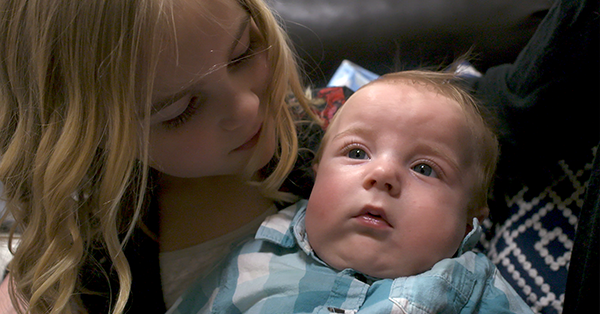
Barrett was born in October of 2018, entering the world with the love and support newborns need to thrive and grow. But Barrett wasn’t like most newborns. Because he was born with congenital diaphragmatic hernia, or CDH, he also needed medical intervention to survive.
When Amanda and Kyle found out in February 2018 that they were pregnant, they were elated. “It took a lot of work to conceive him,” Amanda said, adding that daughters Brittin and Landry shared in the eager anticipation of another family member. In June, Amanda and Kyle had a routine ultrasound to track Barrett’s development, which is when their obstetrician noticed an abnormality in his diaphragm.
Amanda and Kyle were referred to the Fetal Care Center, a partnership between Barnes-Jewish Hospital, Washington University Physicians and St. Louis Children’s Hospital. And that’s where they met a team of specialists, including those with maternal-fetal medicine, ultrasound and neonatology. After two additional ultrasound tests, Amanda and Kyle were told their baby had CDH.
“I’m a nurse,” Amanda said. “Immediately, I knew exactly what that meant.”
CDH occurs when the diaphragm, the muscle that separates the chest from the abdomen, fails to close during prenatal development. This creates a hole through which abdominal organs can migrate into the chest. When that happens, the lungs do not have enough room to develop. In Barrett’s case, his pediatric surgeon, Jesse Vrecenak, MD, said, “his heart was in the right spot, his stomach was where it was supposed to be, but his kidneys were in his chest.”
The day of the diagnosis, Sarah Smith, RN, BSN — one of the nurse coordinators working in the Fetal Care Center — called the family at home to see how they were managing and to answer any questions they might have. At first, Amanda said, she felt angry and, because she and Kyle had lost earlier pregnancies, they both kept wondering “why us?” But it wasn’t too long before Amanda began asking herself, “Why not us? We can take care of this baby; we can give him what he needs.”
Barrett was born with a team of 17 specialists in a delivery room at the Women & Infants Center —all prepared to help him and his mom and dad. Amanda said, “they laid him on my chest for a minute and then whisked him away and took him straight to the NICU” for care. When Barrett was three days old, he had surgery to move his kidneys and close the hole in his diaphragm.
Twenty-seven days later, Barrett went home. He had a nasogastric tube in place, which traveled from his nose to his stomach to deliver breast milk and medicine, and he needed a good deal of therapy, but he was with his family. Members of the St. Louis Children’s Hospital Congenital Diaphragmatic Hernia Clinic will continue to monitor Barrett’s growth and development but, the clinic’s director, Tasnim Najaf, MD said, “I expect Barrett to do totally, completely fine. He's already awesome and he should continue to be awesome.”
His dad, Kyle, said, “In our eyes, he’s perfect. We couldn’t be any more blessed.”